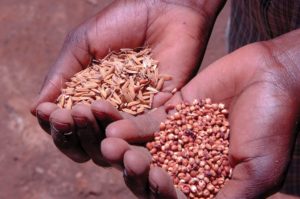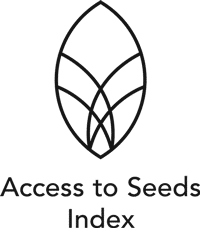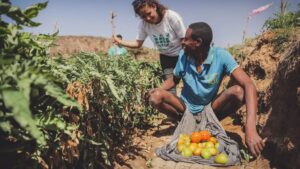Success in agriculture for small farms requires more than enhanced access to seed varieties.
The Access to Seeds Index, to be published at the end of 2015, seeks to identify how seed companies are supporting smallholder farmer productivity, while encouraging them to enhance their roles and responsibilities towards smallholder farmers.
Although representatives of the seed industry acknowledge the importance of seeds and genetic improvement for smallholder farmer productivity, they also express some concerns about the initiative.
The Access to Seeds Index was developed as an initiative to assess the extent to which the world’s leading seed companies use their knowledge, technologies, varieties and seed to benefit smallholder farmers, says Ido Verhagen, executive director of the Access to Seeds Index. “Smallholder farmers represent a yet untapped opportunity to meet global food security challenges. By improving access to quality seeds of appropriate varieties, coupled with the right agronomic practices, the seed industry can play a major role in unlocking this potential.”
Engagement of the private sector is high on the global sustainable development agenda, Verhagen says. “In its evaluation of the Millennium Development Goals, the United Nations highlighted the importance of improved crop varieties that have enabled farmers in the advanced agricultural systems to triple their yields. Based on that, it sees the seed industry as a crucial partner in addressing global food security challenges. I would say that is a big compliment. To bring this a step further, it is essential to better understand the role seed companies can play. The Access to Seeds Index aims to clarify how seed companies are taking up their role and responsibility.”
Michael Keller, secretary general of the International Seed Federation (ISF), says that the ISF recognizes the important role played by seeds and genetic improvements in the fight against hunger and poverty.
“Seed companies the world over work hard to provide farmers with high-quality seed. Seed is, however, only part of the solution to increasing agricultural output, and increasing output is only part of the solution to food security worldwide,” says Keller. “ISF members and companies are working directly with farmers on a global level to find sustainable solutions to the problem of world hunger.”

Stability Needed
However, Keller says the Access to Seeds Index doesn’t address some important factors that are prerequisites for allowing plant breeding innovations to reach smallholders farmers — a stable political, legal and intellectual property framework.
Carl-Stephan Schäfer, secretary general of the German Plant Breeders’ Association (BDP), says that feeding the world is a major issue for plant breeders already, but emphasises that it cannot be made the responsibility of breeders alone.
“Solving the food security problem is more complex than making new varieties. It’s about reducing food waste, plant protection, plant nutrition and so on. Plant breeders consider seed a very important contribution to sustainable intensification. However, this is only possible in an appropriate agricultural setting. New varieties need the respective agricultural practices to realise their genetic potential in the form of higher and more reliable yields, better quality and reduced inputs. And this requires the size and scale of investment and commitment that is only possible if political and legal frameworks favour such investments,” says Schäfer.
Verhagen agrees. “Everybody understands that for the market to flourish, an enabling environment is essential. Therefore the World Bank and Cornell University are evaluating the work that is being done by governments in this respect. The focus of the Access to Seeds Index on the role of the private sector is complementary to that. Together they can inform the discussion on how the public and the private sector reinforce each other’s impact.”
Inspiration

Niels Louwaars, director of Netherlands seed association Plantum, notes there are differences between the seed industry and the pharmaceutical industry, where product development can be done anywhere.
“What might work in one industry is not guaranteed to work in another. It is clear from the evidence that a ‘one size fits all’ approach doesn’t work for a number of reasons. Medicines can be transported from one country to another, and will work. But if you take a European seed variety and plant it in Africa, it might not flourish in the same way,” he says.
“Comparison with the Access to Medicine Index is tempting, but ultimately not very useful due to the huge variety in the size of seed companies. In our industry, only a few companies have a global impact. Most are locally or regionally active and often do not have any relationship with the target areas of the index, [but they] still influence the global food production system since the genetic improvement they produce is available for local breeders and farmers in the countries where smallholder farmers dominate. It is therefore essential that the Access to Seed Index has developed a separate methodology for this index”.
According to Verhagen, the Access to Medicine Index shows that an index can be a powerful tool in better understanding how an industry can contribute. “An index does so by first identifying what stakeholders expect from an industry and then evaluating whether companies meet these expectations. As such, an informed dialogue can start on where companies can step up their efforts, where expectations should be adjusted, or others actors, like governments, should play their part first.”
Following the medicine example, an Access to Nutrition Index was released in 2013. The Access to Seeds Index follows, coming out the end of 2015. “Each Index is fully tailored to the characteristics of the respective industry,” says Verhagen. “Three years of stakeholder consultations, including talks with the seed industry itself, was put into the development of the methodology. Based on that input for instance, the Access to Seeds Index focuses both on global companies as well as on regional companies.
“The methodology acknowledges that smallholder farmer development is complex, challenging and requires more than just the availability of good seeds. In some areas seed companies can have big impact, in others their potential contribution is probably limited. Still, we see that companies are moving beyond their regular scope, as is needed to reach the smallholder customer and open new markets.”
Concerns
While Plantum supports and shares the wider goals of the Access to Seeds Index and its call for social responsibility of companies, Louwaars wonders how organisers will evaluate their impact on smallholder farmers’ food security and wellbeing. “Good seed can only produce wealth in combination with access to land, markets and other policy areas, combined with a good knowledge base that supports agricultural practices,” says Louwaars. “We look forward to the first index and call on the organisers to interpret their findings with utmost care.”
Keller suspects that ISF members, who expressed concerns over the relevance of the index at the outset, will remain critical of the initiative, particularly as the Access to Seeds Index has decided to publish the index on the basis of publicly available information. In his view, ISF members will have to decide for themselves whether they want to participate in the exercise.
The research for the first Access to Seeds Index started in March 2015. The evaluation is based on publicly available information, as well as additional data provided by companies themselves. “The response rate is high. Based on first evaluation of the incoming data, we are confident that the index will show what and where the sector is already doing well and how individual companies are leveraging their strengths,” says Verhagen. “With the findings of this index, we will be able to identify inspiring examples of innovative ways by which companies are supporting smallholder farmer productivity.”













